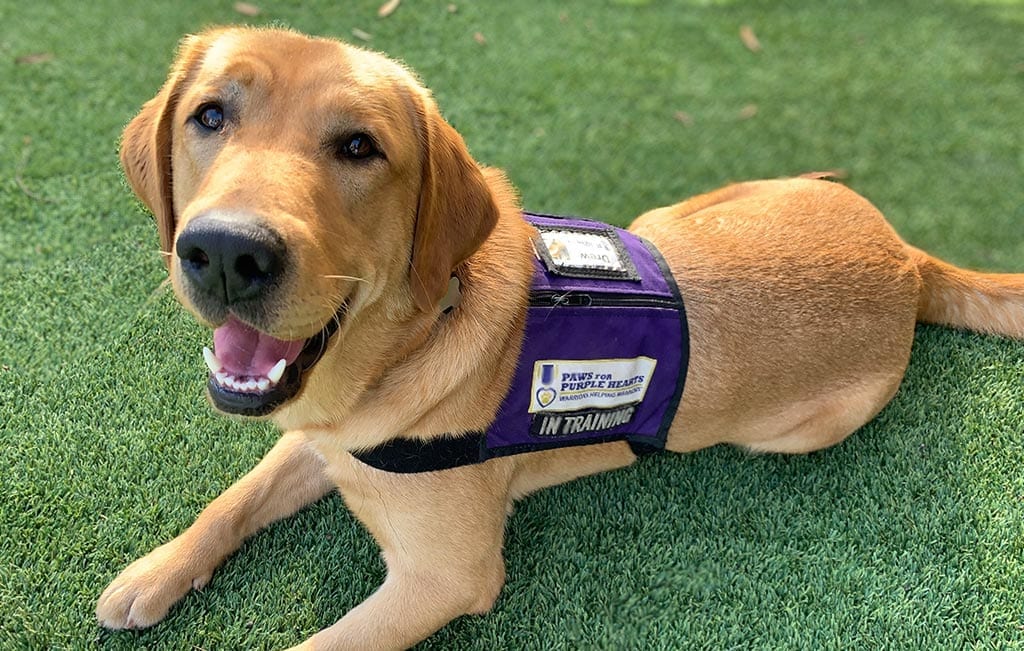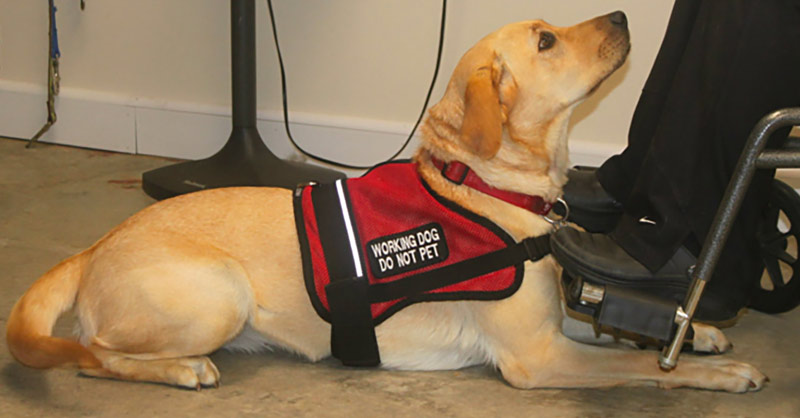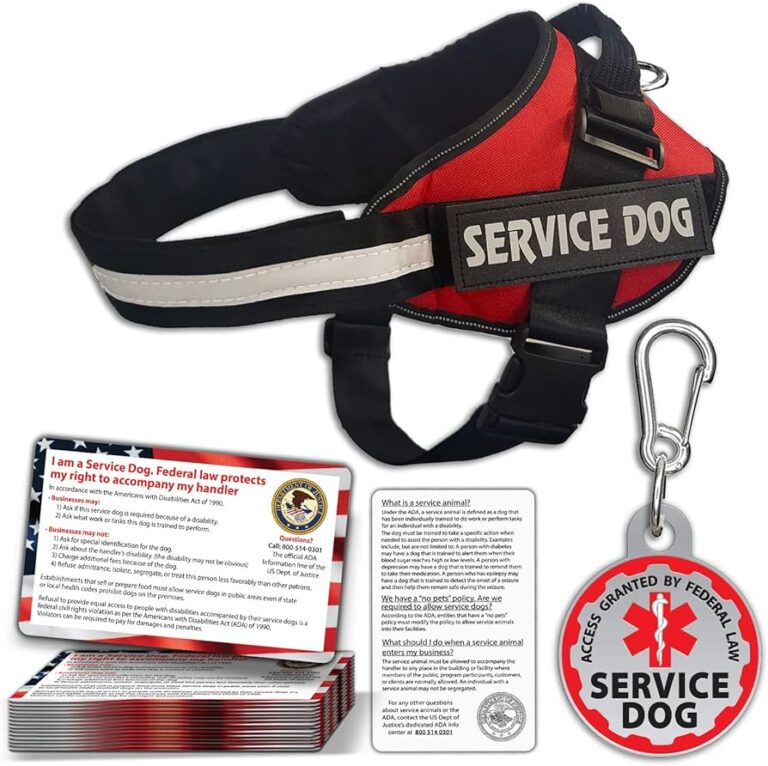No, a service dog is not required to wear a vest or any type of identifying gear according to the ADA. While it can make life easier and let others know that the dog is working and should not be bothered, it is not a legal requirement.
Handlers have the option to dress up their service dogs if they want, but it should not obstruct their movement or vision, or be overbearing. The purpose of a vest is simply to provide easy identification and comfort for the dog.

Credit: www.amazon.com
Do Service Dogs Have To Wear Vests?
When it comes to identifying service dogs, many people wonder if these valuable companions are required to wear vests. The answer is no, service dogs do not have to wear vests according to the Americans with Disabilities Act (ADA), which provides guidelines and protections for individuals with disabilities and their service animals. While vests can make it easier for others to recognize that a dog is a service animal, they are not mandatory for the dog’s identification. However, there are valid reasons why some service dogs wear vests, and there are alternative methods to identify these working animals.
What The Ada Says About Service Dog Vests
The ADA does not specifically require service animals to wear vests, ID tags, or any specific harness. The act focuses on the training and tasks performed by the service dog, rather than their outward appearance. According to the ADA, a service animal is defined as a dog that is individually trained to perform tasks or assist individuals with disabilities. The dog’s training and abilities are more important than any visual identifiers.
Reasons Some Service Dogs Wear Vests
Although it is not obligatory, many handlers choose to have their service dogs wear vests for various reasons. These vests can serve as visual cues for the public, indicating that the dog is a working service animal and not a pet. Wearing a vest can help prevent distractions and unwanted interactions, allowing the dog to focus on its tasks and keep its handler safe.
Additionally, some handlers find that vests make their everyday interactions easier. Vests can help avoid awkward or intrusive questions from others, as it becomes evident that the dog is providing a service to the handler. This can save time and energy for both the handler and the people they encounter throughout the day.
Alternatives To Vests For Identifying Service Dogs
While vests are a commonly used method to identify service dogs, they are not the only option. There are alternative ways to identify these working animals without the use of vests. Some handlers choose to utilize special harnesses or patches that attach to the dog’s harness or collar, indicating its role as a service animal. These patches often contain information such as “Service Dog” or “Do Not Pet,” providing a clear indication to others.
Another alternative is to carry identification cards or documentation that verifies the dog’s status as a service animal. These documents can be shown to those who have questions or doubts about the dog’s role. It is important to note that while these identification methods can be helpful, they are not legally required under the ADA.
In conclusion, service dogs are not legally obligated to wear vests according to the ADA. However, vests can serve as useful tools for both handlers and the public to recognize and respect the working nature of these dogs. If a vest is not used, there are alternative methods such as patches or identification cards that can aid in identifying a service animal. The most significant factor, though, is the dog’s training and ability to assist individuals with disabilities, which remains the primary focus of the ADA.
Service Dogs And Public Access Laws
Service dogs are not legally required to wear a vest or any identifying gear according to the ADA. However, many handlers choose to use vests as it makes it easier for others to recognize that the dog is working and should not be bothered.
Texas Laws Regarding Service Dogs
In the state of Texas, there are laws in place to protect the rights of individuals with disabilities who rely on service dogs for assistance. Under the Texas Disability Law, service animals are defined as dogs that are individually trained to perform tasks for the benefit of a person with a disability. These tasks can include anything from guiding individuals who are visually impaired to alerting those who are deaf or hard of hearing to potential dangers.
Legal Rights And Restrictions For Service Dogs
When it comes to public access, service dogs in Texas are protected by the Americans with Disabilities Act (ADA). This federal law grants individuals with disabilities the right to be accompanied by their service dogs in public places, such as restaurants, stores, and hotels. Service dogs are allowed to enter these establishments even if there are policies in place that prohibit pets.
It’s important to note that while service dogs have legal rights, there are also some restrictions in place. For example, businesses can ask individuals with service dogs to remove them from the premises if the dog is not under control or poses a direct threat to the health or safety of others. Additionally, service dogs are not allowed in certain areas where their presence may interfere with the operation of a facility, such as sterile environments in hospitals.
Can You Ask For Proof Of Service Dog In Texas?
According to Texas law, individuals are not entitled to demand proof or certification of a service dog’s qualifications. The only permissible inquiry is to determine the basic type of assistance provided by the service animal to the person with a disability. This means that you cannot ask for identification, paperwork, or any other form of proof that the dog is a trained service animal.
However, businesses and establishments do have the right to ask if the dog is a service animal required because of a disability and what specific tasks the dog has been trained to perform. Remember, it is important to respect the privacy and dignity of individuals with service dogs and not to pry or make assumptions about their disabilities.
Considerations For Dressing Up Service Dogs
When it comes to dressing up service dogs, there are some important considerations to keep in mind. While it can be fun and cute to dress up our furry friends, it’s crucial to prioritize their comfort and safety above all else. In this blog post, we’ll explore the importance of identifying a working service dog, guidelines for choosing appropriate costumes, and ensuring the comfort and safety of our service dogs.
Importance Of Identifying A Working Service Dog
Identifying a working service dog is essential for both the handler and the general public. Service dogs play a crucial role in assisting individuals with disabilities, and it’s important that others can easily recognize and respect their working status. While the Americans with Disabilities Act (ADA) does not require service dogs to wear a vest or any specific gear, many handlers choose to use these identification tools.
By dressing their service dogs in vests or harnesses, handlers can help others quickly identify their dog as a working service animal. This can be particularly helpful in public settings such as restaurants, stores, or airports, where distractions and interactions can disrupt the dog’s ability to assist their handler effectively. Additionally, it can help prevent well-meaning individuals from unwittingly distracting or engaging with the working service dog.
Guidelines For Choosing Appropriate Costumes
While dressing up service dogs can be fun, it’s crucial to choose costumes that are appropriate and do not hinder the dog’s ability to perform their tasks. Here are some guidelines to consider when selecting costumes for service dogs:
- Ensure costumes do not obstruct movement or vision: Costumes should not impede the dog’s ability to walk, run, or navigate their environment. Avoid costumes with excessive fabric, masks, or accessories that could limit the dog’s field of vision.
- Consider the dog’s comfort: Choose costumes made from lightweight and breathable materials that won’t cause discomfort or overheating. Avoid costumes with tight or restrictive straps that may cause discomfort or restrict the dog’s movement.
- Avoid overbearing costumes: While it may be tempting to go all out with elaborate costumes, it’s important to remember that service dogs are working animals. Opt for costumes that are simple, unobtrusive, and do not draw excessive attention or create unnecessary distractions.
Ensuring Comfort And Safety For Service Dogs
When dressing up service dogs, it’s essential to prioritize their comfort and safety. Here are some additional tips to ensure their well-being:
- Gradually introduce costumes: If your service dog is not accustomed to wearing costumes, introduce them slowly and gradually. Allow them to become comfortable with the costume by letting them sniff and investigate it before putting it on.
- Monitor their behavior and body language: Pay close attention to how your service dog reacts to the costume. If they seem stressed, anxious, or uncomfortable, remove the costume immediately.
- Regularly check for any signs of discomfort or irritation: Ensure the costume is not causing any chafing, rubbing, or irritation on your service dog’s body. Regularly check the fit of the costume and make necessary adjustments to ensure their comfort.
By following these guidelines, you can ensure that dressing up your service dog is a positive experience that doesn’t compromise their well-being or ability to perform their important tasks.

Credit: pawsforpurplehearts.org

Credit: www.servicedogcertifications.org
Frequently Asked Questions For Does A Service Dog Have To Wear A Vest
What Are The Three Questions You Can Ask About A Service Dog?
Service dogs are not required to wear any special gear like vests or patches. However, it can be helpful to identify them as working dogs and prevent distractions. In Texas, it is not legal to ask for proof or qualifications of a service dog.
When dressing up a service dog, make sure they are comfortable and their NEADS vest is visible. It is not a legal requirement for service dogs to wear vests, ID tags, or special harnesses.
Do Service Dogs Need To Wear Gear?
No, service dogs are not required to wear any special gear like a vest or harness. However, some handlers choose to use these items to make it easier for others to identify that their dog is working and should not be bothered.
Can You Legally Ask For Proof Of Service Dog In Texas?
In Texas, it is not legally required to ask for proof of a service dog. Texas Disability Law states that you cannot demand qualifications or certifications of a service animal, except to determine the type of assistance provided. Service dogs are also not required to wear any specific gear.
Can You Dress Up Service Dogs?
No, service dogs are not required to dress up in any specific gear or costumes. However, it is important to have a visible vest or identification for easy recognition as a working service dog. The comfort and mobility of the dog should also be considered when choosing any clothing or accessories.
Conclusion
It is not legally required for a service dog to wear a vest or any specific gear. While it can be helpful in identifying the dog as a working service animal, it is not mandatory. However, many handlers opt to dress their dogs in vests or patches to make it easier for others to recognize that the dog is working and not to be bothered.
Ultimately, the decision to dress a service dog in a vest is up to the handler’s preference and the dog’s comfort.



